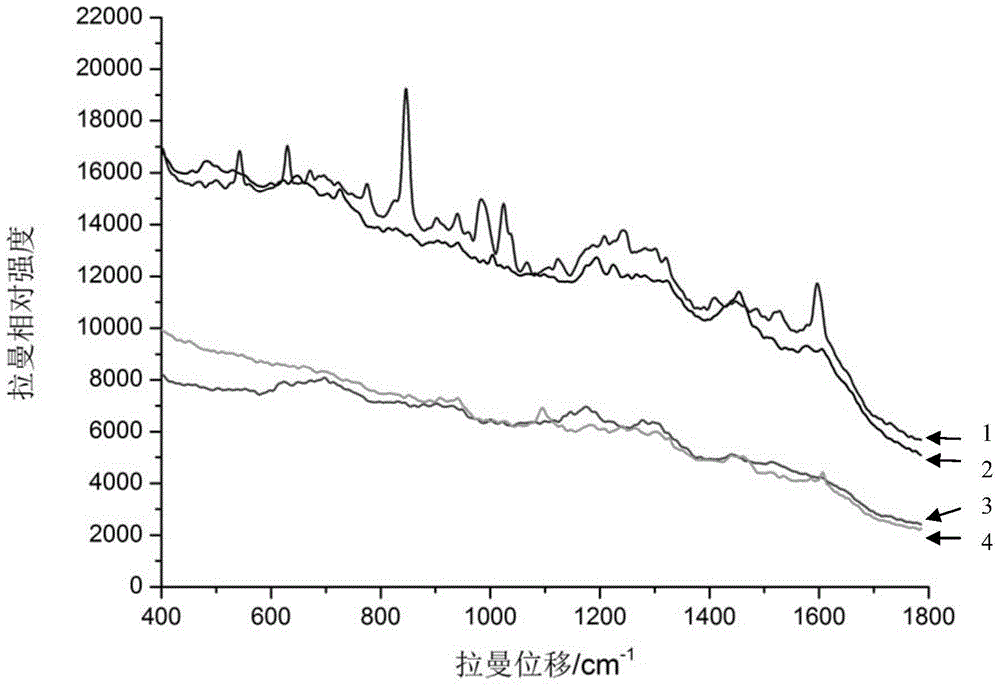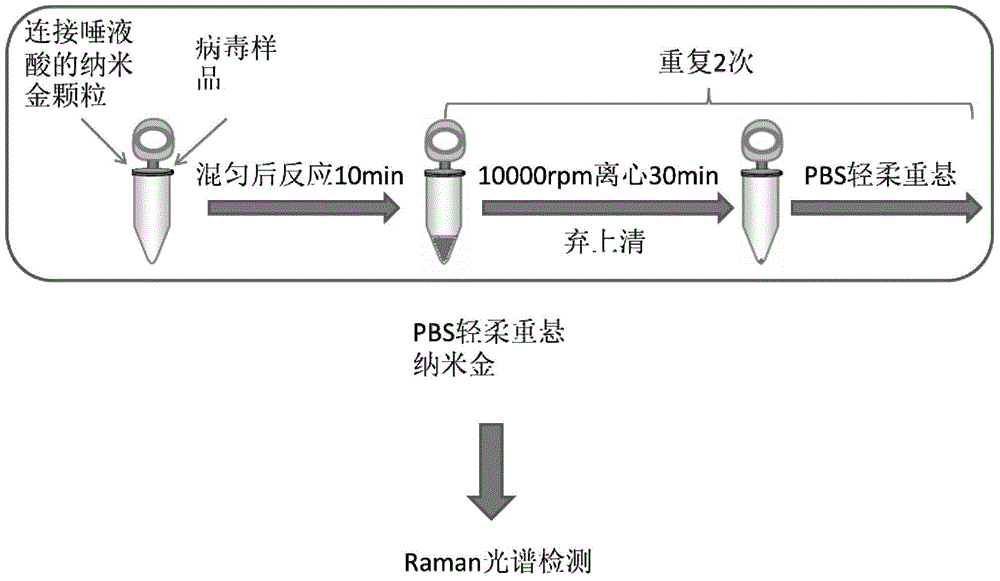Surface enhanced Raman spectra substrate for detecting avian influenza virus, and application thereof
A surface-enhanced Raman and avian influenza virus technology, applied in Raman scattering, material excitation analysis, etc., can solve the problems of low virus content, complex sample components, false negatives, etc., and achieve the effect of rapid detection and identification
- Summary
- Abstract
- Description
- Claims
- Application Information
AI Technical Summary
Problems solved by technology
Method used
Image
Examples
Embodiment 1
[0048] Example 1. Preparation of surface-enhanced Raman spectroscopy substrate for detection of avian influenza virus
[0049] 1. Preparation of gold nanoparticles
[0050] 50mg of chloroauric acid is dissolved in 500ml of ultrapure water, after heating and boiling, add 1% (1g / 100ml) trisodium citrate solution (solvent is water) of 8.7ml, stir vigorously and continue to boil and cool to room temperature after 35min ( 25° C.) to obtain gold nanoparticles with a diameter of about 10-15 nm.
[0051] 2. Preparation of gold nanoparticles coupled with α(2,3) sialic acid oligosaccharides
[0052] 1. Preparation of α(2,3) sialotriose-short connecting chain
[0053] For the specific preparation method, refer to Example 1 of the Chinese patent application with application number 201310495249.x (publication number CN 103551562A). The α(2,3) sialotriose-short connecting chain as shown in formula III below and the short connecting chain as shown in formula III are obtained.
[0054] Fo...
Embodiment 2
[0059] Example 2, Verification of Surface Enhanced Raman Spectroscopy Base Substrate Detection of Avian Influenza Virus
[0060] The gold nanoparticles coupled with α(2,3) sialic acid oligosaccharides obtained in Example 1 were used as a substrate, mixed with different influenza virus samples, and detected by surface-enhanced Raman spectroscopy, and simultaneously set up without adding virus samples. The detection control containing only the substrate, and the non-conjugated sialooligosaccharide gold nanoparticles in Example 1 were selected for the detection control. The specific implementation plan is as follows:
[0061] 1. Take four 1.5ml centrifuge tubes, and add 100 μl of the nano-gold solution coupled with α(2,3) sialic acid oligosaccharides obtained in Example 1 to the three centrifuge tubes, numbered 1, 3, 4, and the other Add 100 μl of unconjugated sialooligosaccharide gold nanoparticles, numbered 2, to the centrifuge tube. Then add 10 μl avian influenza virus A / Vie...
Embodiment 3
[0064] Example 3, Application of Surface Enhanced Raman Spectroscopy Substrates to Detect Different Subtypes of Avian Influenza Viruses
[0065] The gold nanoparticles coupled with α(2,3) sialic acid oligosaccharides obtained in Example 1 are mixed with different influenza virus strain samples respectively as substrates, and then surface-enhanced Raman spectroscopy detection is carried out. The operation flow chart is as follows figure 2 shown. The specific implementation plan is as follows:
[0066] 1. Take four 1.5ml centrifuge tubes, add 100μl of nano-gold solution coupled with α(2,3) sialic acid oligosaccharides, numbered 1, 2, 3, 4, and then add 10μl poultry Influenza virus A / Chicken / Shanghai / 441 / 2009 (H9N2) strain samples (10 7 Virus particles / ml), No. 2 tubes add 10 μl avian influenza virus A / Vietnam / 1194 / 2004 (H5N1) strain sample (10 7 Virus particles / ml), No. 3 tubes add 10 μ l avian influenza virus A / Puerto Rico / 8 / 34 (H1N1) strain samples (10 7 Virus particles / m...
PUM
| Property | Measurement | Unit |
|---|---|---|
| diameter | aaaaa | aaaaa |
| diameter | aaaaa | aaaaa |
| particle diameter | aaaaa | aaaaa |
Abstract
Description
Claims
Application Information
 Login to View More
Login to View More - R&D
- Intellectual Property
- Life Sciences
- Materials
- Tech Scout
- Unparalleled Data Quality
- Higher Quality Content
- 60% Fewer Hallucinations
Browse by: Latest US Patents, China's latest patents, Technical Efficacy Thesaurus, Application Domain, Technology Topic, Popular Technical Reports.
© 2025 PatSnap. All rights reserved.Legal|Privacy policy|Modern Slavery Act Transparency Statement|Sitemap|About US| Contact US: help@patsnap.com



